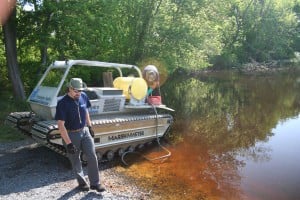
EPA proposes $14 million plan to remove lead and arsenic soil at 33 residential properties in Voorhees and Gibbsboro affected by former Sherwin-Williams paint plant

U.S. Environmental Protection Agency officials said they’re looking at September to officially decide on a recently proposed, $14 million plan to excavate and replace soil contaminated with lead and arsenic on at least 33 residential properties in Voorhees and Gibbsboro as a result of land and waterways contaminated by a former Sherwin-Williams paint manufacturing plant in Gibbsboro.
That was the latest news out of an EPA-hosted public information session at the Gibbsboro Senior Center on June 11 regarding the environmentally hazardous Sherwin-Williams/HilliardsCreek superfund site, the history of which stretches back to the mid-1800s when paint manufacturers first began operating in the area.
The recently proposed plan would be funded entirely by Sherwin-Williams and would be conducted under EPA supervision.
At the June 11 meeting, EPA Remedial Project Manager Ray Klimcsak said Sherwin-Williams has “come to the table” in the processes, which would include digging up soil at the properties and then properly disposing of the soil at offsite facilities equipped to handle such environmental hazardous waste.
Areas where soil was extracted would then be backfilled with new, clean soil, during which time new plant life would be replanted if necessary.
According to Klimcsak, after the EPA potentially reaches what’s known as a Record of Decision in September, the next phase known as “remedial design” would begin, which the EPA’s website describes as the time when the “technical specifications for cleanup remedies and technologies are designed.”
Klimcsak said he thinks it’s reasonable to estimate that shovels could be in the ground within a year-and-a-half to two years, with the process taking about three years to complete.
However, Klimcsak said that while properties near source areas that don’t have the chance to be re-contaminated present themselves as the first to be cleaned up, until the remedial design process is complete, it won’t be known when specific properties will be cleaned.
“During design, we’ll see if there’s a potential for recontamination. If there’s not, the property is going to be cleaned up,” Klimcsak said. “Certainly, a property upstream in Gibbsboro may be cleaned up at the same time a property in Voorhees would be cleaned up. The remedial design phase will certainly shake out some of those details.”
A ROD, which is the final outline of the cleanup plan for a Superfund site, can only be issued after a public comment period in which the EPA accepts public comments or concerns about any proposed actions.
The EPA is accepting comments from members of the public regarding the residential cleanup plan through July 2.
However, for the residents in Voorhees concerned about the health of Kirkwood Lake as a whole, the EPA is still several years away from an official ROD that would outline what remedy would be used for the Kirkwood Lake portion of the Williams/Hilliards Creek Superfund site.
The proposed date for the EPA issuing a ROD regarding Kirkwood Lake is sometime in 2018, which was announced at a community information meeting in January and confirmed by Klimcsak at the June 11 meeting.
As in the past, Klimcsak said the EPA would still first be prioritizing cleanup of residential sites most likely to affect human health, before moving to other affected areas upstream from Kirkwood Lake to reduce the possibility of recontamination.
Those areas include the former Sherwin-Williams manufacturing plant at Silver Lake in Gibbsboro, a Route 561 Gibbsboro dump site, a Gibbsboro United States Avenue burn site, areas of Hilliard’s Creek and the then finally Kirkwood Lake itself.
Voorhees resident Alice Johnston, who has properties along the lake and is president of the Kirkwood Lake Environmental Committee, still questioned why the cleanups couldn’t take place concurrently.
“It’s been 35 years already. Why can’t they clean the lake and the residential properties in concert with cleaning the burn site and the plant site and so and so forth,” Johnston asked. “What does everything need to be piece mailed out?”
Johnston said other possible plans to clean Kirkwood Lake that are being discussed between Sherwin-Williams and Camden County Officials, who control the lake, are still ongoing.
To view the proposed EPA plan for the Sherwin-Williams/Hilliards Creek Superfund site, visit http://www.epa.gov/region02/superfund/npl/sherwin.
Written comments for the residential remediation plan may be mailed or emailed to: Ray Klimcsak, Remedial Project Manager, U.S. EPA, 290 Broadway 19th Floor, New York, New York, 10007–1866 or at [email protected].









